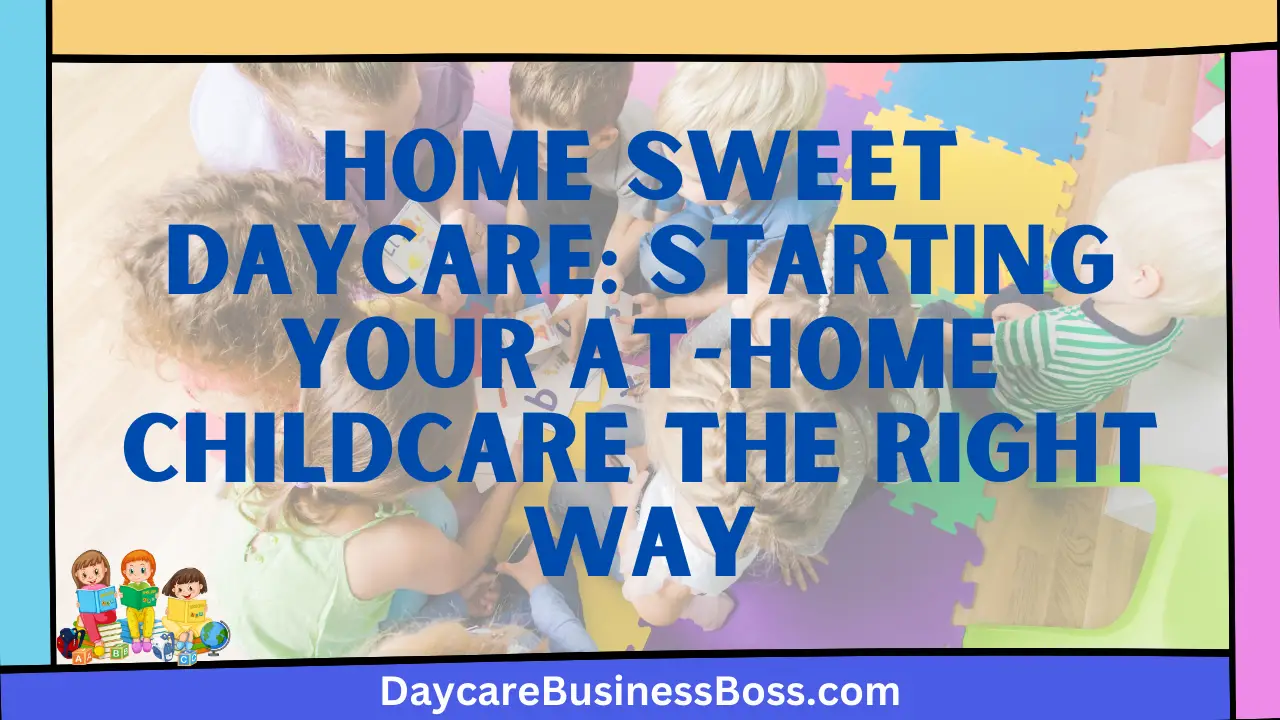As parents seek quality care and education for their children, the need for dependable home-based childcare services grows. This trend offers aspiring entrepreneurs a once-in-a-lifetime opportunity to combine their love of children with a feasible business opportunity. To assure the achievement of an at-home daycare, however, rigorous planning, devotion, and a systematic approach are required.
To best initiate your at-home daycare, you should follow a systematic approach that involves researching local regulations, childproofing your space, creating a curriculum, setting rates, and promoting your services.
In this article, we will delve into the fundamental procedures and considerations that will enable you to change your living area into a safe, nurturing, and enriching environment for children. So, let us embark on this exciting adventure together, delving into the complexities of starting an at-home daycare and unlocking the potential for both personal and professional growth.
The Foundation: Investigating Local Regulations and Licensing

The crucial step of conducting thorough research on local regulations and licensing criteria is at the heart of the quest to start an at-home daycare. As you travel along this path, it becomes clear that each region or country has its own set of rules that govern the operation of home-based childcare providers. As a result, it is critical to approach this first stage with care and dedication.
Your local government or licensing agency should be your initial point of contact. Their advice and knowledge will be important as they navigate the intricate web of regulations that govern childcare providers. You will find a plethora of information here on the permits required to open your daycare, the complexities of background checks, and the high health and safety standards that must be met.
The relevance of certifications and training cannot be understated. Many jurisdictions require daycare operators to complete specialized training or receive certain childcare credentials. This isn’t simply a formality; it’s a way to ensure that the children entrusted to your care receive the best supervision and support possible.
Aside from the legal ramifications, this fundamental step is critical for another important reason: the children’s safety and well-being. By thoroughly studying and following the requirements, you establish an environment that prioritizes the protection of children above all else. Regulatory authorities’ recommendations are intended to establish an atmosphere of security and care, reassuring parents that their children are in skilled hands.
Read more about: Laying the Foundation: Your Journey to Opening a Daycare
Childproofing Your Space: Safety First
The importance of childproofing your living area cannot be stressed when starting an at-home daycare. When you open your doors to the care and development of young minds, creating a loving environment becomes critical. In essence, childproofing becomes a concrete manifestation of your commitment to providing a safe refuge for children to thrive without unnecessary hazards.
The procedure begins with a thorough examination of your living area. This assessment should go beyond a cursory glance, digging into every nook and cranny where potential threats may lie. Sharp corners that could become collision spots, easily available cleaning products that could cause harm, and items that offer choking dangers all require your careful consideration.
The next step is to put safety measures in place, translating your observations into actions that strengthen the safety net around the children in your care. Safety gates act as a barrier against staircases, outlet covers protect against electrical hazards, and cabinet locks keep curious hands out of potentially deadly substances. Heavy furniture that could tip over if not secured must be anchored, reducing the chance of an accident.
This practice is extended by establishing designated child-friendly zones. These meticulously built and properly placed locations serve as safe havens free of potential hazards. Children can explore, play, and learn without being exposed to risks that could jeopardize their safety.
While childproofing improves the security of your daycare, it also sends a clear message: you are committed to the well-being of the children in your care. It demonstrates your commitment to creating an atmosphere in which their development can take place without the unwanted shadows of preventable mishaps. Parents wanting assurance that their children are in a safe environment will take comfort in your rigorous approach to safety.
Creating a Curriculum: Nurturing Early Development
The value of a well-structured curriculum in building a thriving at-home daycare cannot be overstated. A rigorously developed curriculum serves as the underpinning upon which children’s intellectual, emotional, and social development flourishes, much as a good foundation promotes the growth of a sturdy house. It is more than just a list of activities; it is a road plan for establishing an atmosphere that promotes holistic growth and meaningful learning experiences.
To begin, balance is essential. An effective curriculum weaves a tapestry of varied aspects together, effortlessly combining educational activities, playtime, rest periods, and nutritious meals. This balance ensures that children remain interested, active, and nurtured during their time in your care.
The guiding star of curriculum development is age appropriateness. Every age group has different demands, abilities, and interests. Create a program that is tailored to the developmental milestones of the children you wish to serve. Include learning resources that are not only engaging but also appropriate for their cognitive capacities. To excite young minds and assist in skill development, games, and interactive activities should be carefully chosen.
However, it does not stop there. A well-rounded curriculum digs deeper, incorporating early childhood education themes. Consider incorporating activities that help children develop social skills, creating the groundwork for cooperative play and respectful relationships. Incorporate cognitive development exercises, such as problem-solving, critical thinking, and language learning. Through art, music, and imaginative play, youngsters can discover and express their unique strengths.
The beauty of a well-thought-out curriculum extends beyond the immediate classroom experience. It influences parents, who want to know that their children are getting more than just care; they are participating in significant learning activities. Parents observe the real benefit of your daycare as their children bloom under the compassionate embrace of your curriculum, establishing a sense of trust and appreciation.
Setting Competitive Rates: Valuing Your Services

The process of setting your at-home daycare’s pricing structure is analogous to creating a masterpiece—it needs careful deliberation, a touch of creativity, and a thorough awareness of the particular dynamics at work. Finding a happy medium between fair remuneration and enticing pricing is a delicate dance that has the power to impact not just the growth of your business but also the relationships you form with the people you serve.
In this journey, market research will serve as your compass. A careful assessment of local market pricing reveals current norms and expectations. However, your price plan goes beyond the impersonal world of numbers; it is about adequately valuing your service.
Location is an important component that might influence pricing. A daycare in a bustling urban area may command a different rate than one in a bucolic neighborhood. Equally crucial is the level of care you provide. Parents are prepared to invest in a daycare that goes above and beyond the norm, providing their children with a caring, educational, and safe atmosphere.
Your price structure is supported by operational costs. Every aspect of your daycare’s operation has a cost, from staff pay and supplies to utilities and maintenance. Ensuring that your charges sufficiently cover these expenses is not just good business practice, but also a commitment to providing long-term, high-quality care.
However, it is critical to strike a balance between covering costs and being competitive in the local market. Your fees should be affordable for families while still reflecting the value you provide. Transparent communication becomes essential. Outline your pricing structure in detail, breaking out the components that contribute to the total cost. This level of transparency assists potential clients in understanding the value of the services you offer.
Read more about: Exploring Daycare Center Rental Rates: What to Expect and Why
Promoting Your Services: Reaching Your Audience
Effective promotion serves as the beacon that brings families to the oasis you’ve diligently constructed in the crowded environment of at-home daycares. It’s not only about getting customers; it’s about bridging the gap between your love of childcare and the parents looking for a nurturing atmosphere for their children. Remember that each effort you make is a thread that knits a relationship of trust, compassion, and shared values as you embark on this promotional adventure.
Crafting a competent and attractive brand identity is the cornerstone of promotion. A memorable name, a logo that expresses the core of your daycare, and marketing materials that represent your dedication all add to a strong first impression. This initial connection sows the seeds of curiosity in the minds of potential clients.
In today’s digital world, online platforms serve as your canvas on which to create a vibrant picture of the uniqueness of your daycare. Use social media networks to not only promote your products but also to humanize your company. Share glimpses of the loving environment you provide, as well as the small details that set your daycare apart. A dedicated website serves as your online home—a place where families can read testimonials, learn about your philosophy, and imagine their child flourishing in your care.
Collaboration is yet another effective promotional weapon in your arsenal. Establish relationships with local parenting groups, schools, and community centers. These networks act as channels for word-of-mouth communication. Your involvement in these communities demonstrates your determination to be an active and vital part of the local childcare scene.
Open homes and trial days are invaluable experiential opportunities. You create a tangible experience that goes beyond words and visuals by asking parents to visit your childcare. They can see your nurturing environment for themselves, engage with you, and imagine their child in your care.
Frequently Asked Questions

What are the most important rules and licenses to consider when launching an at-home daycare?
Starting an at-home daycare entails following local regulations and obtaining the relevant licenses. Each jurisdiction may have its own set of standards, which may include background checks, inspections for health and safety, and specific training or certifications. Contact your local government or licensing office for detailed information on the measures you must take. Ensuring compliance not only proves your daycare’s legality but also indicates your commitment to providing a safe and secure environment for the children you’ll be caring for.
How do I develop a curriculum for my at-home daycare?
Creating a well-rounded curriculum is critical for delivering beneficial experiences to the children in your care. Begin by adapting your program to the age range you intend to serve. Include a variety of educational activities, playtime, rest periods, and healthy eating. Incorporate age-appropriate learning materials, interactive games, and activities that promote cognitive, social, and creative growth. Stay adaptable and ready to change your program based on the children’s needs and interests. A well-thought-out curriculum not only engages children but also reassures parents of the educational value your daycare provides.
How do I properly market my in-home daycare to attract clients?
Promoting your in-home daycare is critical for boosting your clientele and expanding your business. Begin by developing a strong brand identity, which includes a memorable name, logo, and professional marketing materials. To highlight the distinctive qualities of your daycare, use internet tools such as social media and a dedicated website. Share testimonials, photographs of your childproofed environment, and sneak peeks at your curriculum. Spread the message by working with local parenting organizations, schools, and community centers. Hosting open houses or offering trial days allows prospective parents to have a firsthand look at your childcare. Remember that promotion bridges the gap between your enthusiasm for childcare and the families in need of your services.
To learn more on how to start your own daycare checkout my startup documents here.
The information provided by DaycareBusinessBoss.com (“The Site”) is for general informational purposes only. All information on the Site is provided in good faith, however, we make no representation or warranty of any kind, express or implied, regarding the accuracy, adequacy, validity, reliability, availability or completeness of any information on the Site. Under no circumstance shall we have any liability to you for any loss or damage of any kind incurred as a result of the use of the Site or Reliance on any information provided on the Site. Your use of the Site and your reliance on any information on the Site is solely at your own risk.
This blog post is for educational purposes only and does not constitute legal advice. Please consult a legal expert to address your specific needs. Terms and Conditions. (https://daycarebusinessboss.com/terms-conditions/)

Meet Shawn Chun: Entrepreneur and Childcare Business Fan.
I’m a happy individual who happens to be an entrepreneur. I have owned several types of businesses in my life from a coffee shop to an import and export business to an online review business plus a few more and now I create online daycare business resources for those interested in starting new ventures. It’s demanding work but I love it. I do it for those passionate about their business and their goals. That’s why when I meet a childcare business owner, I see myself. I know how hard the struggle is to retain clients, find good employees and keep the business growing all while trying to stay competitive.
That’s why I created Daycare Business Boss: I want to help childcare business owners like you build a thriving business that brings you endless joy and supports your ideal lifestyle.

